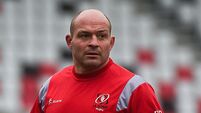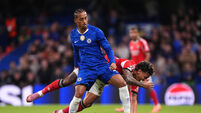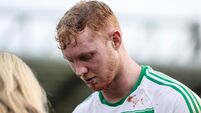How other sports have been dealing with the transgender question

BAN: The IRFU have banned transgender women from contact rugby.
The IRFU’s decision to ban transgender women from contact rugby has brought a spotlight on the rest of Irish sport to update their own policies. The decision making process will differ from sport to sport and some organisations are further down the line than others.
The IRFU has taken its stance with inclusion, fairness, and safety in mind. It says that the term ‘trans inclusion’ essentially ‘means the inclusion of transgender people into the category of their choice’ while fairness ‘means competitive equity in relation to the sex category and in relation to strength, stamina, and physique in gender-affected sport’, while safety ‘refers to safety from the risk of injury’.
According to accompanying data released by the IRFU, there are distinct physical disparities between male and female athletes, noting that a ‘valid comparison should be between elite male and elite female players, between male and female club players, or between male and female secondary school players’. It says that within each of these groups, because of puberty and the influence of androgens/testosterone, the biological male player is between 10% and 20% faster, and 20% and 50% stronger and more powerful than a biological female player competing at the same level’.
Further data presented by the IRFU notes that: ‘There are some women’s players who are heavier than men’s players, but this is only true when a particularly heavy woman (the heaviest 10% of women) is being compared to a relatively light man (the lightest 10% of men). At the other extreme of mismatched comparisons, the heaviest 5% of men’s players are more than twice as heavy as the lightest 5% of women’s players. This highlights that the male physiological attributes far exceed female attributes, which creates both a potential safety risk and performance differences between them’.
The IRFU references ‘recent peer-reviewed research’ which it says ‘provides evidence that there are physical differences between those people whose sex was assigned as male and those as female at birth, and advantages in strength, stamina and physique brought about by male puberty (which) are significant and retained even after testosterone suppression’. The English RFU recently
decided to no longer allow transgender women compete in female contact leagues. Sporting organisations, to one extent or another, have been considering their position in the area and formulating a position for several years.
The issue came to a head recently for the Ladies Gaelic Football Association when a transgender woman, Giulia Valentino, competed for Na Gaeil Aeracha (The Rainbow Gaels), Ireland’s first explicitly LGBTQ+ inclusive GAA club, in the final of a Dublin junior football women’s competition. According to an report, Valentino, originally from Italy, ‘has been an outspoken proponent for transgender people being allowed to play sports in the gender they choose’. She was substituted at half-time in the game. The LGFA has stated it is ‘currently working in consultation with our counterparts in the GAA, and from other sporting organisations, in relation to developing policy in this area’.
The GAA, catering principally for male players, beyond a select few at underage and those who play handball and rounders, hasn’t yet encountered a situation similar to the LGFA. How they will accommodate a transgender man — someone who is assigned female at birth but identifies and lives as a man — remains to be seen. The association has done significant work in the area of embracing the LGBTQ+ community, enjoying a presence at Pride marches among other visible acts while it has a national diversity and inclusion officer, Ger McTavish.
A Gender Diversity Working Group was established in 2019 and its chairperson, Gearoid Ó Maolmhichil, stated in 2020 that its job was to ‘look at the promotion of gender diversity’, noting how the group ‘includes members of each of our gaelic games associations and indeed external people that we’ve invited in as well’.
Asked this June how the GAA is prepared for the transgender question, football referee David Gough told the : “I know that Gearoid Ó Maolmhichil along with Ger McTavish and Teni, which are the Trans Equality Network in Ireland, have been in constant contact with one another around creating a document for transgender athletes within the GAA.
“I think it’s nearly come to full fruition. I haven’t seen the findings but I know they’re actively looking at it and they will come to some sort of decision in the future. How long that’s going to take? I don’t know. But it’s great to think the GAA are doing that since 2020. It was a major issue for them to even acknowledge that gay people exist in their association in 2015. It’s come a long way and they are making strides.”
The Football Association of Ireland released the following statement to the when contacted: “The FAI is currently reviewing our gender eligibility policy and will consult with all relevant stakeholders including Uefa and Fifa.”
Fifa, which governs world soccer, has similarly stated it is reviewing its transgender eligibility policies.
It made the statement after new rules were passed in swimming restricting transgender participation in women’s events. FINA, swimming’s world governing body, has a policy which states transgender women can only compete in women’s competitions if ‘they can establish to FINA’s comfortable satisfaction that they have not experienced any part of male puberty beyond Tanner Stage 2 (of puberty) or before age 12, whichever is later’.
Cycling’s governing body, UCI, has updated its rules and brought in stricter eligibility criteria including lowering the maximum plasma testosterone level permitted for transgender female athletes.
World Athletics president Seb Coe has hinted that they could follow swimming’s lead. He said his responsibility ‘is to protect the integrity of women’s sport.... and if it means that we have to make adjustments to protocols going forward, we will’.
History was recently made in darts when New Zealand’s Victoria Monaghan became the first transgender player to qualify for a world championship, next January’s WDF world championship at the famous Lakeside Country Club, Frimley Green.
The event is split into men’s and women’s sections and Monaghan, who has transitioned to female in recent years, will compete in the women’s section after winning the New Zealand Women’s Open last month.











